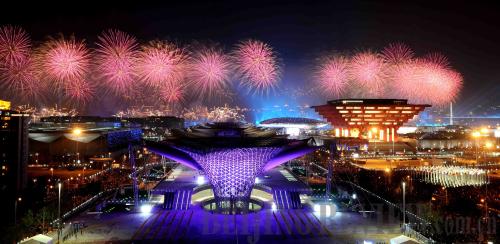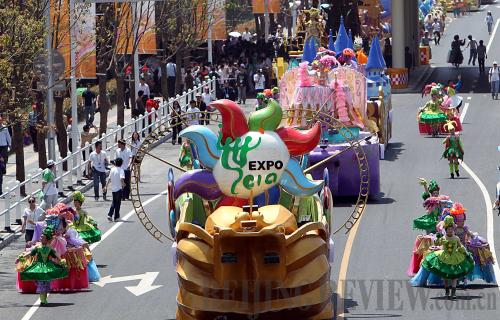|
 |
|
ILLUMINATED SKY: Fireworks are launched during the opening ceremony at the World Expo on April 30 night (CHEN KAI) |
People around the world hailed the opening of the 2010 World Expo on the evening of April 30, a proud curtain-raising ceremony featuring a hi-tech display of dazzling artistic performances, laser lights and fireworks. Around 8,000 spectators watched the two-hour opening ceremony on the Expo site live, including Chinese President Hu Jintao and 20 foreign leaders.
The Expo organizers said a total of 189 countries and 57 international organizations are participating in the six-month event, the largest number in the history of the international gala.
The Expo is expected to draw 70 million people to the pavilions, to reflect the theme of urban sustainability embodied by the slogan, "Better City, Better Life."
Cultural show
 |
|
EXPO FESTIVITIES: Actors wearing festive costumes perform during a grand parade at the World Expo site in Shanghai on May 3 (FAN JUN) |
The ceremony started at 8:10 p.m. Beijing time with a star-studded indoor ceremony and performance.
Speaking at the ceremony, Chinese Vice Premier Wang Qishan said, "The World Expo will lead to a new way of life, and promote harmony between man and nature as well as the overall development of human beings."
Jean-Pierre Lafon, President of the International Exhibitions Bureau, addressed the opening ceremony in Chinese, English and French, saying that he hoped Expo 2010 would contribute to "a social awakening so that cities may become more sustainable, fairer, safer and more harmonious."
The organizer decided to keep the opening ceremony simple yet meaningful.
"The performance aimed to send a signal of harmony, showcasing the sincerity and new vision of the world from the bottom of Chinese people's hearts," Teng Junjie, Chief Director of the indoor performance, told Beijing Review. "So I think there was no need for exaggeration in terms of stage settings."
Multiculturalism was one of the highlights of the ceremony. The four-act indoor show included performances by Chinese pianist Lang Lang, veteran Japanese musician Shinji Tanimura, Italian tenor Andrea Bocelli, the South African Soweto Gospel Choir and the Maori Dance Theater of New Zealand.
During the last act of the performance, Kekyi Wangmo and Jangba Tsering, two ethnic Tibetan children who lost their parents in the 7.1-magnitude earthquake in Yushu, northwest China's Qinghai Province, on April 14, were invited to the stage, standing hand in hand with children from three families with different skin colors—yellow, black and white—to share the joy of the Expo's opening.
"This symbolized the fact that only by means of unity can human beings cope with difficulties and move forward," Teng said.
Environment friendly
The main stage inside the Expo Cultural Center was decorated with biodegradable materials and LED energy-saving light bulbs, which played an important part in what organizers called "the largest light show ever attempted."
A special matrix, composed of 770 small balls and designed by the University of Science and Technology of China, was introduced in a large-scale performance for the first time. The computer-controlled system suspended from the ceiling displayed a dove flapping its wings, a 3-dimensional model of the China Pavilion, and the word "Expo." A total of 12 aerial balls then appeared at the front of the stage, swinging gracefully to the rhythm of the music, and changing color with the lights.
The outdoor show was dazzling as well. A total of 220 flag boats proceeded toward the Lupu Bridge; 6,000 glowing LED balls with a diameter of 0.5 meter each were released into the Huangpu River. The 250-meter-wide musical fountains and the smiling faces of people from different countries appeared on the LED screen to "greet" the audience.
More than 100,000 low-carbon shells with "less smoke, less noise, and more colors" made their way toward Shanghai's moonlit sky as part of the fireworks show, which "echoed the concept of sustainable development of the Shanghai Expo," said Liu Wenguo, an official with the Bureau of Shanghai World Expo Coordination. In addition, the show program and prop bag that each spectator received were made from recycled materials. There were some 2,000 benches for the outdoor audience, each of which was made from 856 recycled milk and soft drink containers.
David Atkins, executive producer of the outdoor show, said the two biggest challenges were time pressure and the venue, as his team had to create an outdoor show across four districts and 3.5 km along the high-traffic Huangpu River within five months.
"It's a very ambitious task," Atkins said. "This is an extraordinary example of Chinese technology and ability to facilitate extraordinary things in such a short period of time."
| 